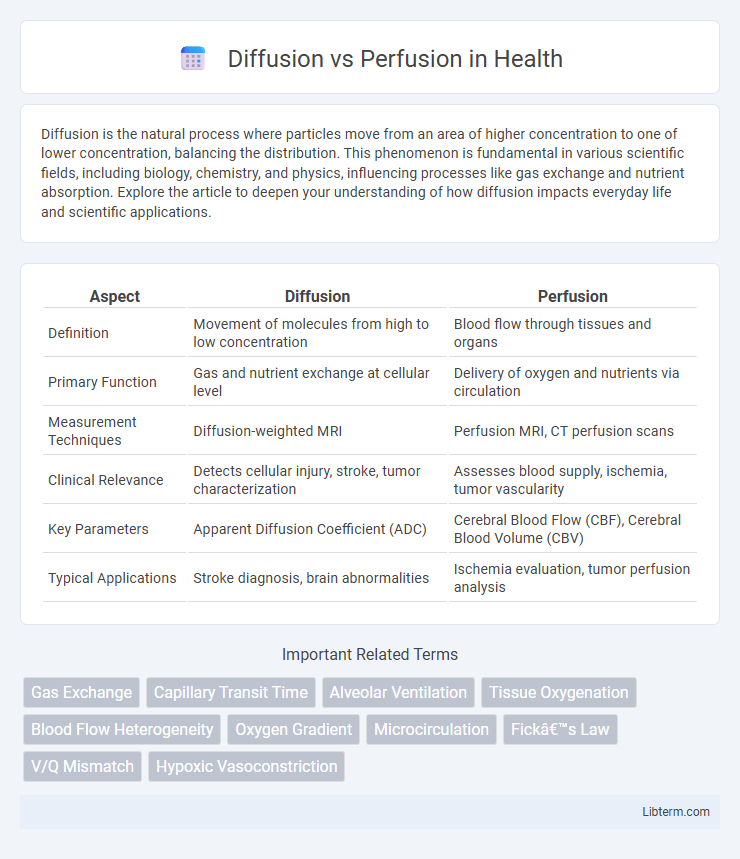Diffusion is the natural process where particles move from an area of higher concentration to one of lower concentration, balancing the distribution. This phenomenon is fundamental in various scientific fields, including biology, chemistry, and physics, influencing processes like gas exchange and nutrient absorption. Explore the article to deepen your understanding of how diffusion impacts everyday life and scientific applications.
Table of Comparison
| Aspect | Diffusion | Perfusion |
|---|---|---|
| Definition | Movement of molecules from high to low concentration | Blood flow through tissues and organs |
| Primary Function | Gas and nutrient exchange at cellular level | Delivery of oxygen and nutrients via circulation |
| Measurement Techniques | Diffusion-weighted MRI | Perfusion MRI, CT perfusion scans |
| Clinical Relevance | Detects cellular injury, stroke, tumor characterization | Assesses blood supply, ischemia, tumor vascularity |
| Key Parameters | Apparent Diffusion Coefficient (ADC) | Cerebral Blood Flow (CBF), Cerebral Blood Volume (CBV) |
| Typical Applications | Stroke diagnosis, brain abnormalities | Ischemia evaluation, tumor perfusion analysis |
Introduction to Diffusion and Perfusion
Diffusion refers to the passive movement of molecules from an area of higher concentration to lower concentration, driven by the concentration gradient, and is critical in processes such as gas exchange in the lungs and nutrient transport in tissues. Perfusion describes the active delivery of blood to capillary beds in biological tissues, ensuring oxygen and nutrient supply to cells while facilitating waste removal. Understanding the distinction between diffusion and perfusion is essential for interpreting physiological functions and pathological conditions such as ischemia and edema.
Defining Diffusion: Key Concepts
Diffusion refers to the passive movement of molecules, such as oxygen and nutrients, across cellular membranes driven by concentration gradients to achieve equilibrium. In biological systems, diffusion plays a critical role in gas exchange, nutrient absorption, and waste removal at the cellular level. Understanding diffusion involves key concepts like Fick's law, which quantifies the rate based on membrane surface area, concentration difference, and membrane permeability.
Understanding Perfusion: Core Principles
Perfusion refers to the process of delivering blood to the capillary bed of biological tissue, ensuring the supply of oxygen and nutrients essential for cellular metabolism. It is measured by parameters such as blood flow rate (mL/min/g tissue) and capillary density, which influence tissue oxygenation and waste removal. Accurate assessment of perfusion is critical in medical fields like cardiology and neurology for diagnosing conditions such as ischemia and stroke.
Mechanisms of Diffusion in the Body
Diffusion in the body involves the passive movement of molecules from an area of higher concentration to lower concentration, driven by concentration gradients across semi-permeable membranes. This mechanism facilitates the exchange of gases like oxygen and carbon dioxide in the alveoli of the lungs and at the cellular level, where nutrients and waste products are transferred between blood and tissues. Factors impacting diffusion efficiency include membrane thickness, surface area, and the partial pressure difference of the diffusing substances.
The Process of Perfusion in Tissues
Perfusion in tissues refers to the process by which blood delivers oxygen and nutrients to capillary beds, enabling cellular metabolism and waste removal. This process depends on adequate cardiac output and arterial pressure to maintain effective blood flow through microcirculation. Tissue perfusion is critical for maintaining homeostasis, influencing oxygen exchange rates and supporting cellular function in organs such as the brain, muscles, and kidneys.
Diffusion vs Perfusion: Main Differences
Diffusion measures the passive movement of molecules, primarily water, across cell membranes, reflecting tissue cellularity and the integrity of cell membranes. Perfusion assesses blood flow through capillaries, providing information on tissue vascularization and oxygen delivery. The main differences lie in diffusion's focus on molecular motion within tissue and perfusion's emphasis on blood supply and hemodynamics.
Clinical Significance: Why Differentiating Matters
Differentiating diffusion from perfusion is crucial in clinical settings as it guides diagnosis and treatment strategies, particularly in stroke management where diffusion-weighted imaging identifies acute ischemic injury while perfusion imaging assesses blood flow deficits. Accurate distinction helps determine tissue viability and guides interventions like thrombolysis or surgery to salvage at-risk brain regions. Understanding these differences supports tailored patient care, improving outcomes in cerebrovascular disease and other conditions involving impaired blood flow or tissue damage.
Common Disorders Affecting Diffusion and Perfusion
Common disorders affecting diffusion include pulmonary fibrosis and acute respiratory distress syndrome (ARDS), where thickened alveolar membranes impair gas exchange efficiency. Perfusion abnormalities often arise in conditions such as pulmonary embolism and chronic obstructive pulmonary disease (COPD), resulting in disrupted blood flow and inadequate oxygen delivery. Both diffusion and perfusion impairments contribute significantly to hypoxemia and compromised respiratory function.
Diagnostic Techniques for Assessing Diffusion and Perfusion
Diffusion-weighted imaging (DWI) and perfusion-weighted imaging (PWI) are advanced MRI techniques used to assess tissue characteristics, with DWI measuring the random Brownian motion of water molecules to detect cellular density and ischemic changes. Perfusion imaging employs dynamic susceptibility contrast (DSC), dynamic contrast-enhanced (DCE) MRI, or arterial spin labeling (ASL) to quantify cerebral blood flow, volume, and permeability, aiding in the evaluation of tumor vascularity and stroke severity. These diagnostic modalities complement each other by providing crucial insights into tissue viability and vascular function, enhancing clinical decision-making in neurological and oncological disorders.
Future Directions in Diffusion and Perfusion Research
Future directions in diffusion and perfusion research emphasize integrating advanced imaging techniques, such as diffusion tensor imaging (DTI) and dynamic susceptibility contrast (DSC) MRI, to enhance diagnostic precision in neurological disorders. Machine learning algorithms are increasingly applied to interpret complex diffusion and perfusion data, enabling personalized treatment planning and real-time monitoring of therapeutic efficacy. Efforts to standardize acquisition protocols and improve spatial-temporal resolution aim to facilitate multi-center studies and accelerate the translation of research findings into clinical applications.
Diffusion Infographic

 libterm.com
libterm.com